Regional election in Tyrol, 25 September 2022
Günther Pallaver
Professor Emeritus of Political Science, Senior researcher at Eurac ResearchIssue
Issue #3Auteurs
Günther Pallaver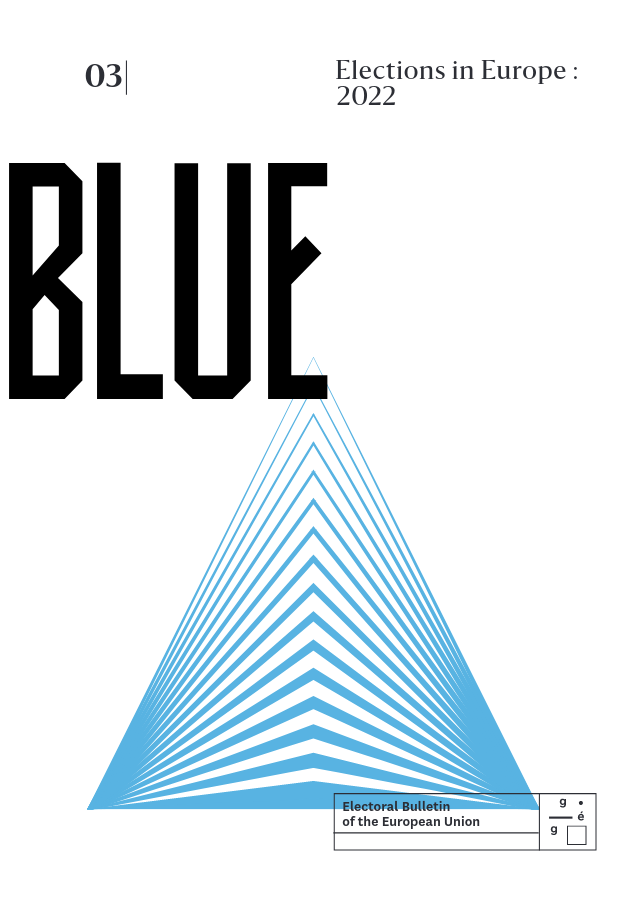
Issue 3, March 2023
Elections in Europe: 2022
Initial situation and context
The Tyrol, known throughout Europe since the 1800s thanks to its mountains and the emergence of alpinism, was still deeply Catholic and politically conservative in the decades following World War II. The saying “Loyalty is Tyrolean custom” was confirmed by the conservative Austrian People’s Party (ÖVP) receiving a high share of the vote election after election. In light of the results of the latest regional elections that were held on September 25, 2022, not much seems to remain of these golden times, when the ÖVP was assured to secure an absolute majority.
Apart from the municipal council and mayoral elections in Burgenland and Tyrol, the state parliament election was the first ballot to take place since Sebastian Kurz‘s resignation as chancellor and federal chair of the ÖVP in October 2021. Due to the allegations of corruption that caused this resignation, the ÖVP slid into a genuine political crisis. In this context, the election in Tyrol was also seen as a kind of barometer of sentiment for the federal government and the two coalition partners, the ÖVP and the Greens.
Neither of the governing Tyrolese parties could count on a tailwind from Vienna, unlike the Freedom Party and, to a limited extent. the Social Democrats. Beyond the dimensions that are usually in the focus of election research, such as social change, the economic cycle, the volatility of the electorate, etc., genuinely regional dynamics have affected the electorate‘s behavior.
In the early days of the Covid-19 pandemic, as the contagious disease broke out in the well-known winter sports resort of Ischgl, Tyrolese regional leaders were heavily criticized for their distrastrous crisis management. Throughout Europe, Ischgl became synonymous with political incompetence and cynicism; those responsible at both the state and local levels were accused of putting sales figures before the health of their guests (Schröder, 2020).
The state government did not really regain its footing after this crisis management disaster. The incumbent governor, Günther Platter (2008-2022), who was also the chairman of the Austrian People’s Party (ÖVP), announced after a long wait that he wanted to run again, but shortly afterwards changed his mind and declared that he would not be available to run in the next election.
Willing to block the way for some of those seeking to succeed him, Platter surprisingly presented Anton Mattle (born in 1963), a regional councillor for economic affairs, as his successor. In view of the People‘s Party‘s poor poll results, no one within the ÖVP who opposed Mattle at the party conference, and he was elected the new party chairman with 98.9% of support (cf. Die Presse, 2022).
However, Platter retained his office as regional governor instead of making a clear change. Had he held the office of governor himself at the time of the election, Mattle would have had a much stronger standing in the election campaign (cf. Karlhofer, 2022).
In June, the polls predicted a disastrous election result for the ÖVP, with a vote share frequently below 30%. In order to signal a new beginning with the future governor Mattle and to detach itself from the negative electoral dynamics of the federal ÖVP, the Tyrolean People’s Party ran under the list sign “MATTLE – Anton Mattle Tyrolean People’s Party.” Many election posters only carried the name “Mattle.” This was intended to signal Tyrolean independence and distance the regional party from the federal ÖVP (Willim, 2022). Regional governor Wendelin Weingartner (1993-2002) had already used a similar strategy when he tried to avoid association with the federal ÖVP as much as possible, using the corporate design “Wir Tiroler” (We Tyroleans) to insulate himself from the negative trend of the federal party (cf. Gehler, 2004: 250). But while Weingartner successfully employed this strategy, Mattle did not.

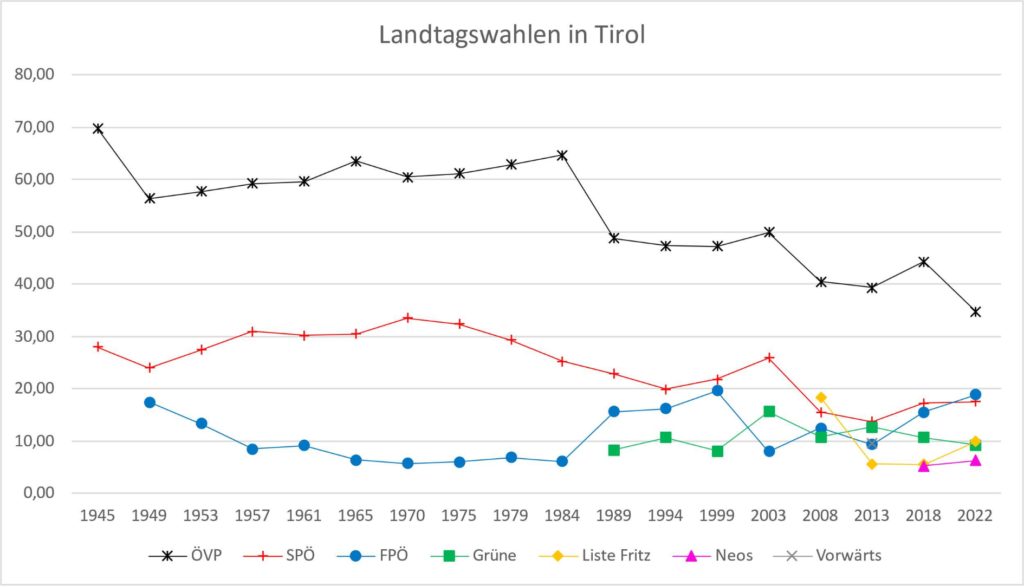
Spurred on by the good poll results, the FPÖ tried to challenge the ÖVP‘s leadership, but did not succeed in this intent (Arora, 2022a). At least since the abolition of proportional representation in Tyrol in 1999, the FPÖ falls under the conventio ad excludendum, by which other parties exclude the Freedom Party from any coalition. The SPÖ hoped for a strong boost from Vienna, but this did not materialize. The Greens, who had been in government with the ÖVP for almost ten years, first had to cope with the departure of their deputy regional governor, Ingrid Felipe, and were unable to free themselves from their longstanding tandem with the ÖVP. The Greens were often tied together politically with the ÖVP when a list of failures was to be drawn up: it was always the Greens who had adapted to ÖVP politics, not the other way around. The Neos and Liste Fritz, a 2008 split from the ÖVP, were considered outsiders.
The confidence crisis
Besides other factors, the state election was characterized by a strong loss of trust in politics. Trust is a central factor for any political system and one of the most important “synthetic forces” (Simmel, 1992: 393) within a society, which builds on a positive correlation between the performance of a democratic system and the level of social capital present in a society. Trust forms an important prerequisite for cooperation, which in turn is a prerequisite for building a society that has a high level of attention for the common good.
The trust in Tyrolese regional politics, which was quite high in the past, seems to be eroding from one regional election to the next.
In response to the question: “Do you agree with the following statements very much, quite a bit, a little or not at all? I trust that politics in Tyrol will find good solutions to the challenges ahead,” 51% of eligible voters said they had a great deal or quite a bit of trust in politics. The other half of society, on the other hand, no longer had any trust. Compared to the 2018 state elections, trust in the problem-solving competence of politics fell by 20% from 73% to 51%. ÖVP voters still have the greatest trust with 85%, followed by the Greens (50.0%) and the SPÖ (49%). The lowest percentages were recorded by Liste Fritz and the FPÖ, each with 33%. 55% of non-voters have no confidence in politics.
Under these circumstances, it is not surprising that almost half of those eligible to vote (47%) view the evolution of the political situation since the last regional elections negatively, while only 15% see a positive development (35% none). Four years ago, on the other hand, 32% of eligible voters were positive, and only 17% negative. Concerns about the division of society plague almost 80%; four years ago, the figure was significantly lower at 66%.
This negative mood among the population is also expressed in other ways. For example, 89% of eligible voters stated that life in Tyrol is becoming increasingly difficult to afford. In 2018, this share was 73% (Cf. Sora/ISA, 2022: 6-8).
Despite an increasing trend towards personalization of politics, only 37% would have voted for the top candidate of the ÖVP, Anton Mattle, in a direct election of the state governor, followed by Markus Abzwerger of the FPÖ with 15% and Georg Dornauer of the SPÖ with 14%.
Related to this are also the main reasons for voting for a party. Among ÖVP voters, 18% voted for the party because of its top candidate. In the case of Liste Fritz, the figure was ten percent, while the FPÖ (6%) and the SPÖ (only 4%) could have run for election without a top candidate.
It is striking that, despite the erosion of its electorate, the Austrian People’s Party (ÖVP) can still count on 28% of core voters, while the Social Democratic Party (SPÖ) still has 17% and the Freedom Party (FPÖ) only 5%; the other parties can no longer draw on this group of voters.
Due to the early re-election in September 2022, the election campaign was very short and therefore rather unspectacular. As far as policy issues are concerned, the election campaign primarily discussed those that also dominated the political agenda at the federal level. The topics of inflation and rising prices were discussed by 54% of voters during the pre-election campaign. This was followed by affordable housing and securing energy supplies (37% in each case). Security and war as well as environment and climatic protection occupied with i the third place in the ranking with 26% each, followed by health care. The issue of traffic, which has been hotly debated in the Tyrol for years — due, in particular, to the flows of heavy goods that transit through the Tyrol —, was discussed by 23%. Topics that are usually ridden by right-wing populist parties, especially immigration and integration, came in at 19%, followed by Covid (18%), jobs and working conditions (18%), and, far behind, education and schools at 16%.
The electoral result
With a turnout of 65.0% (2018: 60.0%), the outcome of the ballot was historical in at least two respects. For the first time in its history, the Tyrolese ÖVP fell below 35%. Whereas the party under Governor Günther Platter had scored 44.2% on the wake of Chancellor Sebastian Kurz‘s refoundation of a “turquoise” ÖVP in 2018, the ÖVP fell back to 34.7% in September. Given the ÖVP’s disastrous scores in the polls before the election, its lead candidate Mattle presented himself as the savior of his party and thus as the election winner, despite the loss of almost ten percent of the vote. The second novelty concerns the Freedom Party of Austria (FPÖ), which with 18.8% and a plus of 3.3% has become the second largest party in Tyrol. The gap between the largest and second-largest party had never been so small in the past: while it was still 27.1% after the 2018 elections (ÖVP: 44.3%; SPÖ: 17.2%), the gap was halved to 15.9% in the 2022 elections (ÖVP: 34.7%; FPÖ: 18.8%).
In Figure a, which shows the results of the state elections since 1945, the voter trend can be seen and it can be seen when the traditional two-and-a-half party system opened up and gradually developed into a multiparty system.
In 2003, the ÖVP still had a share of about 50% of the vote and 20 seats (out of 36 state parliament seats); in 2022, it won only 34.7% and 14 seats.
The ÖVP loses three seats in the 2022 state elections, while the FPÖ increases its share from 5 to 7, the SPÖ gains one seats from 6, while the Liste Fritz gains one seats and now has three. The Greens, still represented with 4 seats in the last state parliament, lose one. The Neos keep their two seats.
Election winners from the perspective of seat gains are thus the FPÖ, the SPÖ, the Liste Fritz. The ÖVP and the Greens are on the losing side. The Neos are stagnating.
The performance of female candidates deserves a specific attention. There are 14 women in the Tyrolean state parliament, which is one more than in the 2018 state elections, representing 38.9% (2018: 36.1%) compared to 61.1% men (2018: 63.9%).
There are differences between the parties in terms of gender balance. The Greens have the highest proportion of elected women with 66.7%, which is a strong improvement compared to 2018 (25.5%). They are followed by the Neos with 50.0%, who were previously represented in the state parliament by two men. The SPÖ is close behind with 42.8%, up from 50% in 2018. The ÖVP is at 35.7% and loses a share of 5.5%, especially since it had 41.2% of women in parliament in 2018. Liste Fritz comes in at 33.3% (2018: 50%), and the FPÖ is in last place with 28.6% (2018: 20%).
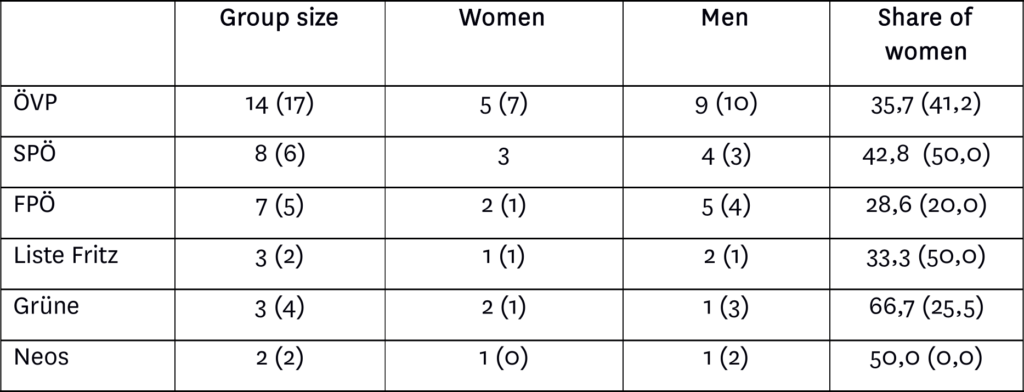

Voter flows
Compared to the 2018 state elections, the ÖVP lost to all other electoral lists, except the Greens, with whom it formed a coalition for almost ten years, according to the Sora Voter Flow Analysis. The Mattle list was able to retain 69% of its 2018 voters. However, the People’s Party lost 16,000 votes to the SPÖ, 9,000 to the Freedom Party, 6,000 to the FRITZ list and 5,000 to the NEOS. The ÖVP was able to compensate for these losses by mobilizing non-voters (8,000). However, 4,000 ÖVP voters from 2018 did not go to the polls this time.
The SPÖ was able to win back 61% of its 2018 voters. The Social Democrats lost the most to Liste Fritz (6,000 votes) and to the Greens (3,000). These losses were more than offset by gains from the ÖVP (16,00 votes).
Of all electoral lists, the FPÖ succeeded most clearly in retaining its voters from 2018 with 72%. The exchange of voters between the ÖVP and the FPÖ is in favor of the Freedom Party. Non-voters proportionally supported the FPÖ the most (15,000). The Greens were able to retain only 58% of their 2018 voters. They lost 3,000 votes each to ÖVP and Neos, and something came back from former non-voters.
Liste Fritz was able to win over 65% of its 2018 voters again. 6,000 votes each came from the ÖVP and the SPÖ, but the list lost 2,000 votes to the Neos. The Neos managed to retain 40% of their voters from 2018. The ÖVP gained 5,000 new votes, but Neos votes also went to the ÖVP, albeit to a lesser extent. The List Austria – People’s Freedom Fundamental Rights (MFG), a movement that is critical of vaccination or even opposed to it, did not make it into the state parliament. Their striking success in the 2002 state elections in Upper Austria (6.2% and three seats) did not repeat itself, likely due to the flattening of the pandemic in Tyrol (Tiroler Tageszeitung, 2021). (All data from SORA, 2022).
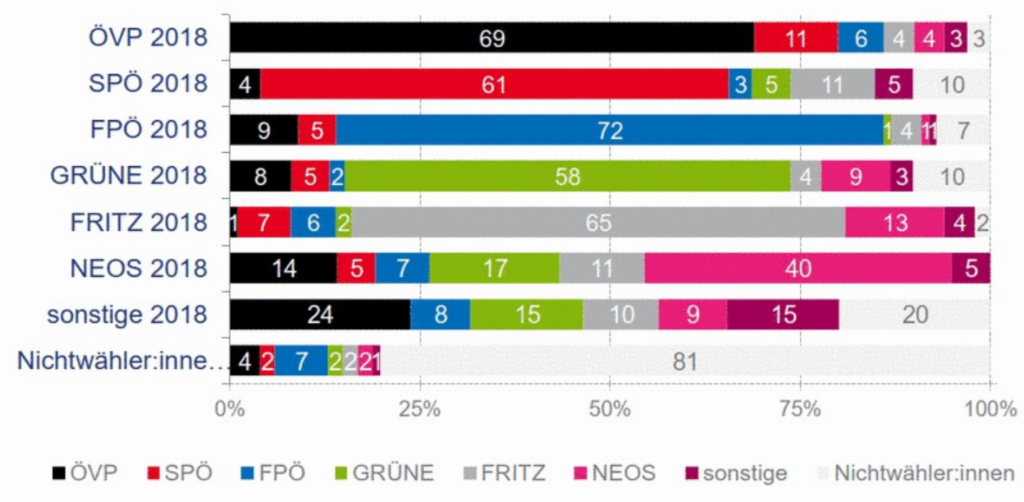
The new state government and a look into the future
The new provincial government of the ÖVP and SPÖ, controlling 21 of 36 seats in the state legislature, replaces the previous ÖVP-Green government after two legislative periods. The eight government offices are shared between five representatives of the ÖVP and three of the SPÖ. Compared to the previous legislative period, there is no parity among the sexes in the government. Namely, five men face three women, two being from the ÖVP (out of five), and one from the SPÖ (out of three).
The Tyrolese regional governement was considered exemplary in terms of gender balanced under Governor Platter, who presided over two legislative periods marked by gender parity in governement. The proportion of women fell from 50.0% to 37.5% in 2022.
Although the balance of power has changed, the distribution of portfolios has remained roughly the same. Despite its electoral defeat, the ÖVP retained all key portfolios, such as finance, regional corporations and regional planning. The SPÖ manages more intangible resources such as integration and social benefits (cf. Tiroler Tageszeitung, 2022). Despite a declining consensus at the state level, the ÖVP still remains the dominant political force in Tyrol, due not only to the distribution of portfolios, but also to the capillary influence of professional associations such as the Farmers’ and Business Associations. The dominance at the municipal level, where the ÖVP is still the “mayor’s party,” should not be underestimated despite some electoral erosion. Significant organizations that structure the political system remain within the ÖVP’s sphere of influence.
Governor Toni Mattle‘s early months as party chairman were not uncontroversial. In particular, the economic sectors of the party had strong reservations about the former mayor of Galtür, who first joined the government while being a regional councilor in 2021. However, the almost 100% consensus in his election as chairman of the People’s Party gave Mattle strong backing. His quick and skillful formation of a government with the SPÖ has, for the time being, broken the dynamics of his last critics within the party. Above all, the fact that Mattle entered into a government agreement with the SPÖ and no longer with the Greens (an ÖVP-Green government would have been without a parliamentary majority) has reassured tourism experts, who did not always agree with the ecological ideas of the Greens.
An uncooperative behavior of the SPÖ is not to be expected. After almost ten years in opposition, the Social Democrats have achieved one of their election goals and are once again the governing party, although they do not want to be subordinated to the crisis-ridden People’s Party (Arora 2022b). The Austrian People’s Party (ÖVP), however, will play the political first fiddle as it always has, while the Social Democratic Party (SPÖ) will provide for the background music.
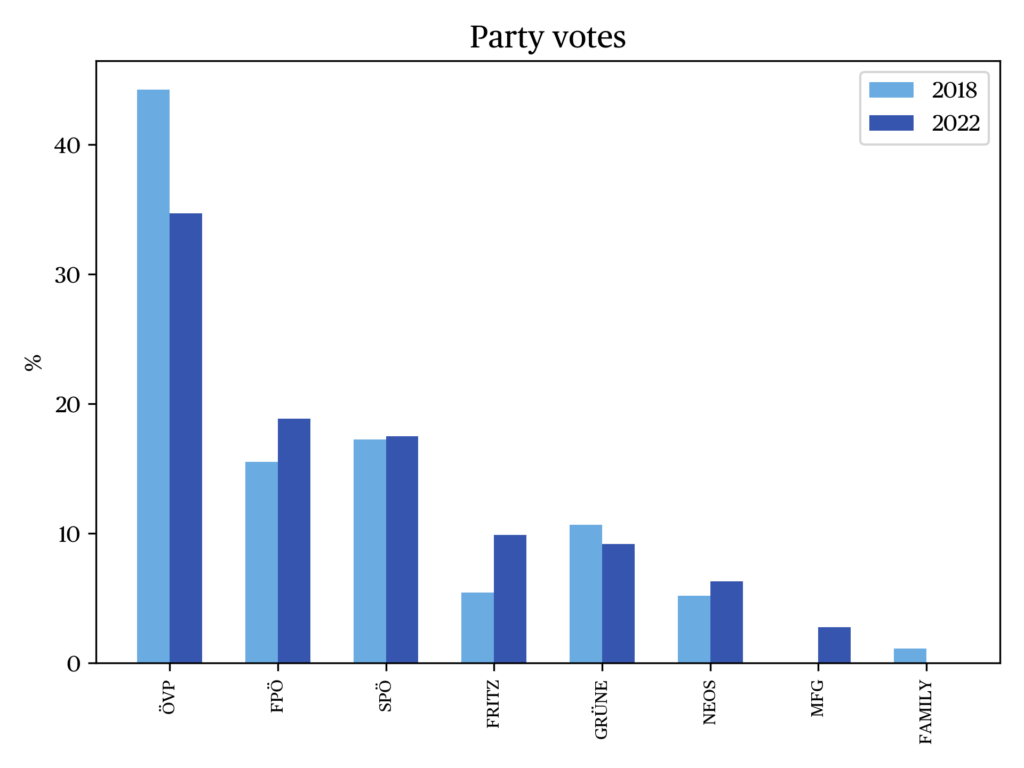
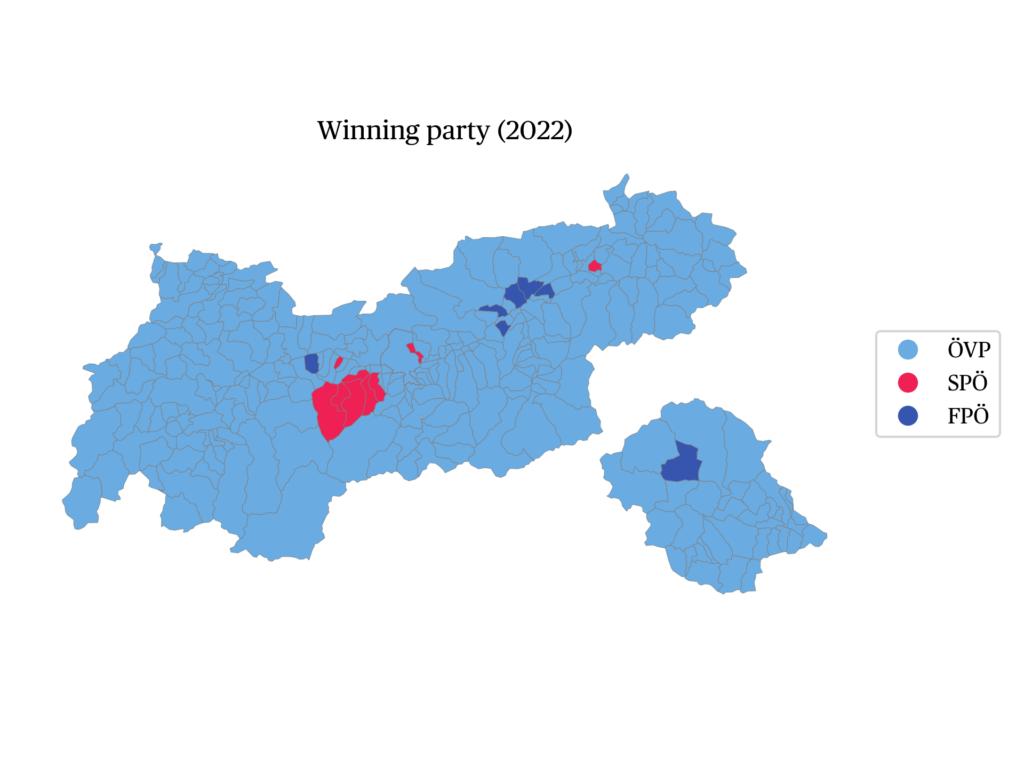

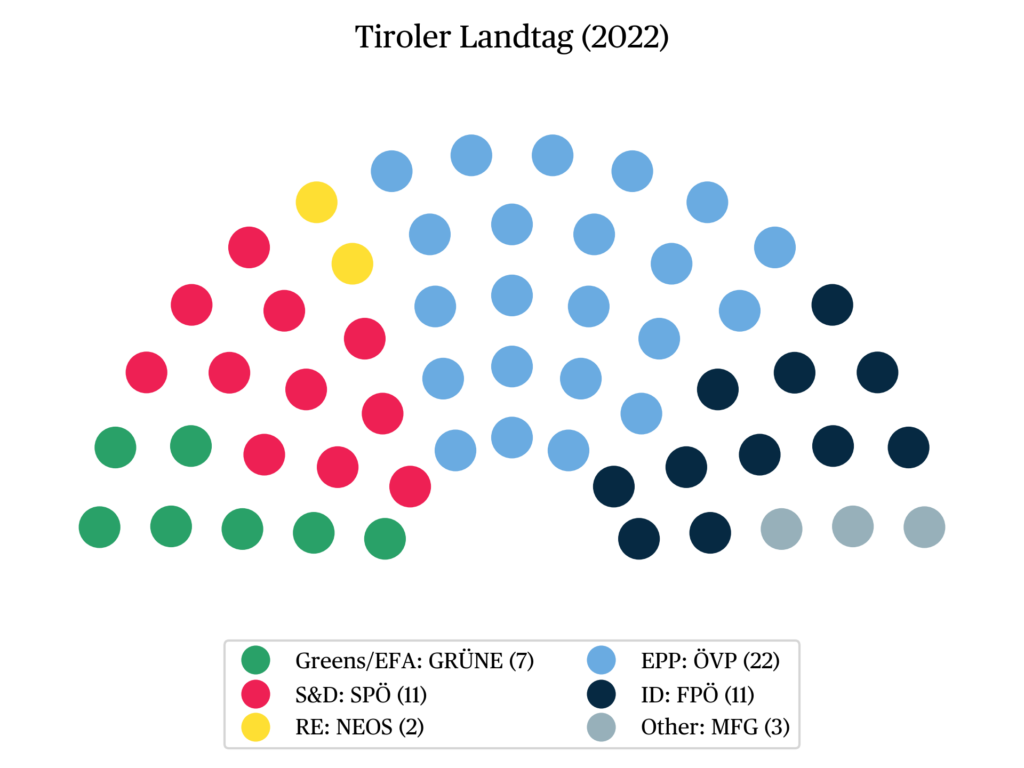
References
Arora, S. (2022a, 6 September). Mattles politisches “Himmelfahrtskommando” an der Tiroler VP-Spitze. Der Standard. Retrieved 18.11.2022.
Arora, S. (2022b, 20 September). Georg Dornauer: “SPÖ wird nicht Steigbügelhalter für zerrüttete ÖVP”. Der Standard. Retrieved 20.12.2022.
Die Presse (2022, 9 July). Mattle mit 98,9 Prozent zu Tiroler ÖVP-Obmann gewählt. Retrieved 18.11.2022.
Gehler, M. (2004). Aufbrüche zur Moderne. Die Amtszeit von Tirols Landeshauptmann Wendelin Weingartner 1993-2002. In Karlhofer, F. & Pelinka, A. (eds.), Politik in Tirol, Innsbruck/Wien/München/Bozen: StudienVerlag: 245-275.
Karlhofer, F. (2018). Die Landtagswahl 2018. Rebellion und Beharrung in Tirols Parteienlandschaft. In Karlhofer, F. & Pallaver, G. (eds.), Politik in Tirol. Jahrbuch 2019, Innsbruck/Wien/Bozen: StudienVerlag: 29-42.
Karlhofer, F. (2018, 6 August). Übergabe ohne Weitblick. Tiroler Tageszeitung: 2.
Land Tirol (2022). Landtagswahl 2022. Landesergebnis. Retrieved 17.11.2022.
News ORF.at (2022, 25 September). Tiroler ÖVP sucht Koalitionspartner. Retrieved 20.12.2022.
Schröder, C. (2020, 6 June). Schlicht und ergreifend widerwärtig. Die Zeit. Retrieved 18.11.2022.
Simmel, G. (1992). Soziologie. Untersuchungen über Formen der Vergesellschaftung. Frankfurt/M.: Suhrkamp.
SORA (2022). Landtagswahl in Tirol. Retrieved 18.11.2022.
Sora/ISA (2022, 25 September). Wahltagsbefragung und Wählerstromanalyse. Landtagswahl Tirol 202. Retrieved 18.11.2022.
Tiroler Tageszeitung (2021). ÖVP verteidigt Platz 1 bei OÖ-Wahl klar, FPÖ vor SPÖ, MFG & NEOS im Landtag. Retrieved 19.11.2022.
Tiroler Tageszeitung (2022). Mehr vom Gleichen mit neuen, alten Gesichtern?. Retrieved 24.10.2022.
Traweger, C. & Pallaver, G. (2020). Die Europaregion Tirol-Südtirol-Trentino. Neue Herausforderungen grenzüberschreitender Zusammenarbeit. Ergebnisse einer Bevölkerungsbefragung. Innsbruck: Studia Verlag.
Wiener Zeitung (2022). Wahlergebnisse seit 1945. Retrieved 20.12.2022.
Willim, C. (2022, 19 July). Tirols neuer VP-Chef Mattle hat seine Liste für die Landtagswahl. Kurier. Retrieved 20.12.2022.
citer l'article
Günther Pallaver, Regional election in Tyrol, 25 September 2022, Mar 2023, 103-108.
à lire dans cette issue
voir toute la revue





